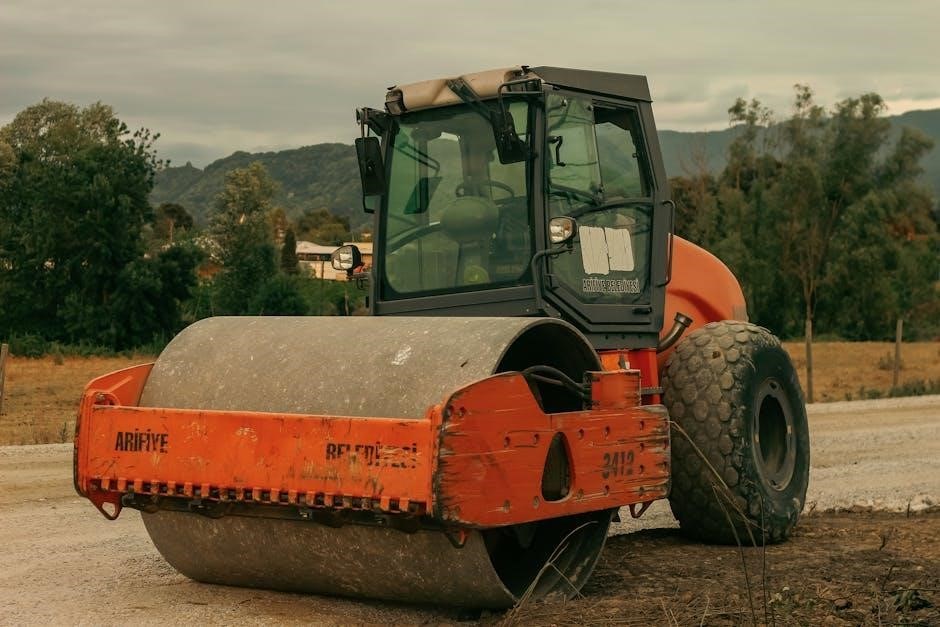Manual rubbish compactors efficiently reduce waste volume, offering a cost-effective solution for waste management. They are ideal for both residential and commercial use, enhancing space efficiency and promoting environmental sustainability.
What is a Manual Rubbish Compactor?
A manual rubbish compactor is a device designed to compress trash, reducing its volume for easier disposal. It operates without electricity, relying on manual force or hydraulic systems. Ideal for homes, offices, and restaurants, these compactors are durable and space-efficient, making waste management more convenient while minimizing environmental impact through reduced waste volume.
Benefits of Using a Manual Rubbish Compactor
- Space Efficiency: Reduces waste volume significantly, allowing for less frequent emptying and more space utilization.
- Cost-Effective: Lowers waste disposal costs and minimizes the need for plastic bags, offering long-term savings.
- Environmental Impact: Decreases landfill use by compressing waste, promoting sustainability and eco-friendliness.
- Convenience: Easy to operate manually, making it suitable for homes, offices, and small businesses.
- Durability: Built to withstand regular use, ensuring reliability over time.

Types of Manual Rubbish Compactors
Manual rubbish compactors come in hydraulic, mechanical, and other specialized variations, each designed to meet specific needs and environments, ensuring effective waste management solutions across various settings.
Hydraulic Manual Compactors
Hydraulic manual compactors utilize hydraulic pressure to compress waste, offering significant force with minimal effort. They are ideal for heavy-duty applications, reducing waste volume substantially. These compactors are durable and efficient, making them suitable for industrial and commercial environments where high-capacity waste management is essential. Their ease of operation and longevity contribute to their popularity in large-scale operations.
Mechanical Manual Compactors
Mechanical manual compactors rely on gears and levers to compress waste, offering a simple yet effective solution. They are lightweight and portable, making them ideal for small-scale applications. These compactors are easy to maintain and operate, requiring minimal physical effort. Their compact design suits residential or small commercial spaces, providing a cost-effective and eco-friendly alternative for waste management needs.
Other Variations
Besides hydraulic and mechanical types, other manual compactors include specialized models designed for specific waste types, such as food waste or recyclable materials. Some compactors feature adjustable compression settings or multi-chamber designs for separating waste. Compact, under-sink models are popular for kitchens, while heavy-duty versions cater to small businesses. These variations enhance efficiency, reduce odors, and maintain cleanliness, offering practical solutions tailored to diverse needs and spaces.

Design and Construction
Manual rubbish compactors are built with durable materials, ensuring long-term reliability. Their compact designs prioritize space efficiency, while safety features like secure lids and ergonomic handles enhance usability and prevent accidents.
Key Components of a Manual Rubbish Compactor
A manual rubbish compactor typically includes a durable container for waste storage, a compression mechanism such as a lever or handle, and a locking system to secure the contents during compression. Additional components may feature a release mechanism for emptying compacted waste and safety features to prevent accidental operation. These elements work together to ensure efficient and safe waste management.
Materials Used in Construction
Manual rubbish compactors are often constructed using durable materials such as stainless steel, heavy-duty plastic, or steel alloys for strength and longevity. Rubber components may be incorporated for sealing and noise reduction. These materials are chosen for their resistance to corrosion, ability to withstand heavy use, and ease of cleaning, ensuring the compactor remains functional and hygienic over time.
Structural Integrity and Durability
Manual rubbish compactors are designed for robust performance, ensuring long-term reliability. Their frames are typically reinforced for stability, and thick, heavy-duty materials are used to withstand consistent use. Many models feature rust-resistant coatings and sturdy hinges to endure harsh environments. Regular testing ensures these compactors can handle heavy loads without compromising safety or functionality, making them a reliable choice for waste management needs.
Operation and Maintenance
Manual rubbish compactors are simple to operate and maintain, requiring regular cleaning and lubrication of moving parts to ensure optimal performance and prevent malfunctions over time.
How to Use a Manual Rubbish Compactor
To use a manual rubbish compactor, first ensure the area is clear and safe. Place waste inside the compactor, avoiding overfilling. Close the lid securely and operate the handle or lever to compress the rubbish. Repeat until full, then carefully empty the compacted waste into a disposal bin. Regularly clean the compactor to maintain hygiene and functionality.
Maintenance Tips for Longevity
Regularly clean the compactor to prevent waste buildup and odors. Lubricate moving parts to ensure smooth operation. Inspect for wear and tear, replacing components as needed. Store the compactor in a dry place to avoid rust. Follow manufacturer guidelines for repairs and upgrades. Proper maintenance extends lifespan and efficiency, ensuring reliable performance over time.
Troubleshooting Common Issues
Identify jams by checking for oversized items or debris buildup. If compression fails, ensure the compactor is not overloaded and the lid is fully closed. For leakage, inspect seals for damage and tighten loose parts. Lubricate hinges if the handle is stiff. Addressing these issues promptly ensures smooth operation and prevents major breakdowns. Regular checks help maintain functionality and efficiency over time.

Space Efficiency and Waste Reduction
Manual rubbish compactors optimize space by reducing waste volume, making them ideal for areas with limited storage. They enhance efficiency and minimize waste management efforts significantly.
Maximizing Space with a Manual Compactor
Manual rubbish compactors are designed to optimize space by significantly reducing waste volume. Their compact design makes them ideal for small areas, allowing efficient use of available storage. By compressing trash, they minimize the need for frequent disposal, saving both time and effort. This makes them perfect for residential and commercial settings where space is limited but waste management is essential. They offer a practical solution for maximizing space while maintaining cleanliness and organization.
Waste Volume Reduction Capabilities
Manual rubbish compactors excel at reducing waste volume, often compressing trash by up to 70%. This significant reduction minimizes the space occupied by waste, allowing for more efficient storage and disposal. By compacting materials like paper, plastic, and cardboard, these devices make waste management more streamlined. The compression process ensures fewer waste containers are needed, reducing disposal frequency and enhancing overall efficiency in both residential and commercial environments.
Environmental Impact of Reduced Waste
Manual rubbish compactors significantly reduce waste volume, leading to a positive environmental impact. By minimizing landfill use, they decrease greenhouse gas emissions from decomposing waste. Compact waste also reduces the need for frequent collections, lowering fuel consumption and carbon footprint. Additionally, compactors promote recycling by separating and compressing materials, conserving natural resources and energy. This sustainable approach supports a circular economy and reduces environmental pollution, making manual compactors an eco-friendly waste management solution.

Cost-Effectiveness
Manual rubbish compactors reduce waste disposal costs by minimizing the frequency of collections and lowering transportation expenses. They also extend bin lifespan, offering long-term financial benefits.
Initial Investment vs. Long-Term Savings
Manual rubbish compactors require an initial investment, but they offer substantial long-term savings. By reducing waste volume, they decrease disposal frequency, lowering overall costs. Unlike automatic compactors, manual models are cost-effective and require minimal maintenance; This balance makes them a financially prudent choice for waste management, providing both immediate and sustained economic benefits.
Reducing Waste Disposal Costs
Manual rubbish compactors significantly reduce waste disposal costs by minimizing the volume of waste. This leads to fewer collection trips and lower disposal fees. Businesses and households benefit from reduced transportation expenses and landfill charges. Compact waste also extends bin capacity, further cutting costs. This efficient solution helps conserve resources while lowering overall expenditure, making it a practical choice for cost-conscious waste management.
Comparing Costs with Traditional Methods
Manual rubbish compactors often prove more cost-effective than traditional waste management methods. While initial purchase costs may be higher, long-term savings from reduced waste volume and disposal frequencies offset expenses. Lower maintenance and operational costs enhance their economic appeal, making them a viable, budget-friendly solution for efficient waste management.

Safety Considerations
Proper training and protective gear are essential when operating manual rubbish compactors to prevent injuries. Ensure the device is used on stable ground and follow load limits to avoid accidents.
Safe Handling and Operation
Always wear protective gear like gloves and safety glasses when using a manual rubbish compactor. Ensure the device is on a stable, even surface to prevent tipping. Never overload the compactor beyond its capacity, as this can cause mechanical failure. Keep children and pets away during operation. Follow the manufacturer’s instructions for proper handling and avoid using the compactor in wet conditions to minimize slip hazards. Regularly inspect the machine before use to ensure all parts are secure and functioning correctly. Proper training is essential to operate the compactor safely and efficiently. Avoid distractions while compacting waste, and always maintain a firm grip on the handle to control the mechanism effectively. Following these guidelines helps prevent accidents and ensures smooth operation.
Precautions to Avoid Accidents
Always ensure the manual rubbish compactor is used on a flat, stable surface to prevent instability. Wear protective clothing, including gloves and closed-toe shoes, to avoid injuries. Keep loose clothing and long hair tied back to avoid entanglement. Never operate the compactor near open flames or sparks. Ensure the area is well-ventilated to prevent inhaling dust or debris. Avoid compacting hazardous materials like batteries or chemicals. Regularly lubricate moving parts to prevent jamming. Keep the compactor out of reach of children and pets. Follow the manufacturer’s weight and size guidelines to avoid overloading. Always maintain a safe distance from the compactor during operation. Proper training is essential to handle the device safely and efficiently.
Emergency Procedures
In case of an emergency, immediately stop the manual rubbish compactor and disconnect the power source. If a jam occurs, do not attempt to remove debris while the machine is operational. Evacuate the area if there’s a risk of further damage or injury. Contact a professional for complex repairs. In case of injury, provide first aid and seek medical assistance if necessary. Never restart the machine until it is deemed safe.

Comparison with Other Waste Management Solutions
Manual rubbish compactors offer a cost-effective, space-efficient alternative to traditional waste bins and automatic compactors, ideal for small-scale applications with lower waste volumes and budgets.
Manual vs. Automatic Compactors
Manual rubbish compactors are cost-effective, low-maintenance, and ideal for small-scale waste management, whereas automatic compactors offer higher efficiency and faster operation, suited for large-scale applications. Manual compactors require physical effort but eliminate the need for electricity, making them eco-friendly and budget-friendly. Automatic compactors, while more powerful, incur higher initial costs and operational expenses. Manual compactors are perfect for residential or small commercial use, while automatic models are better for industrial or high-traffic environments. Both options cater to different needs, ensuring optimal waste reduction.
Advantages Over Traditional Trash Cans
Manual rubbish compactors offer significant advantages over traditional trash cans by reducing waste volume, minimizing odors, and maintaining cleanliness. They prevent pests and scavengers from accessing waste, enhancing hygiene. Compactors also reduce the frequency of waste disposal, lowering costs and labor. Their space-saving design makes them ideal for small areas, while durability ensures long-term use. They are eco-friendly and promote efficient waste management, making them a practical upgrade from conventional trash cans.
When to Choose a Manual Compactor
A manual rubbish compactor is ideal for small businesses, households, or spaces with limited waste generation. It is cost-effective for low to moderate waste volumes. Perfect for reducing waste disposal frequency and costs. Suitable for environments where manual operation is manageable. Eco-friendly option for minimizing waste volume and environmental impact. Best for small-scale applications where simplicity and efficiency are prioritized.

Case Studies and Real-World Applications
Manual rubbish compactors are widely used in apartments, restaurants, and small offices. They help reduce waste volume, save space, and lower disposal costs effectively.
Residential Use Cases
Manual rubbish compactors are ideal for apartments, homes, and small households. They efficiently reduce waste volume, saving space in bins and minimizing odors. For families, they compact kitchen waste, pet litter, and recyclables. In urban areas with limited storage, they help manage waste until collection. Compact design suits small spaces, making them a practical solution for eco-conscious homeowners seeking to reduce their environmental footprint and lower disposal costs effectively.
Commercial Use Cases
Manual rubbish compactors are widely used in offices, restaurants, and retail stores to manage moderate waste volumes. They are ideal for compacting paper, cardboard, and food waste, reducing bin space and collection frequency. In busy environments, they help maintain cleanliness and efficiency. Small businesses benefit from their cost-effectiveness and ease of operation, making them a practical choice for managing commercial waste without requiring significant space or resources.
Industrial Use Cases
Manual rubbish compactors are essential in industrial settings for handling large volumes of waste, such as metal, plastic, and cardboard. They efficiently reduce waste size, minimizing storage space and disposal costs. Factories and warehouses use them to streamline waste management, ensuring a cleaner environment and improving operational efficiency. Their durability and reliability make them a practical solution for heavy-duty industrial applications.
User Reviews and Feedback
Users praise manual rubbish compactors for their efficiency, ease of use, and space-saving benefits, though some note physical effort required. Durable and effective in reducing disposal costs.
Positive Experiences with Manual Compactors
Many users highlight the efficiency and space-saving benefits of manual rubbish compactors. They praise the reduction in waste volume, which lowers disposal costs and frequency. Compact design suits small spaces, making them ideal for homes, offices, and cafes. Durable construction and easy maintenance are frequently commended. Users also appreciate the environmental impact of minimizing landfill contributions. Overall, manual compactors are seen as practical, cost-effective solutions for everyday waste management needs.
Common Complaints and Concerns
Some users report challenges with manual rubbish compactors, such as difficulty compressing bulky or hard materials. The physical effort required can be tiring for extended use. Additionally, occasional odors from compacted waste and the need for regular cleaning are noted as drawbacks. While generally effective, these compactors may not suit all users, particularly those seeking entirely hands-off waste management solutions.
Testimonials and Recommendations
Many users praise manual rubbish compactors for their efficiency and space-saving design. One homeowner noted significant reduction in waste volume, making bin changes less frequent. A business owner highlighted cost savings on disposal fees. Experts recommend regular maintenance to ensure optimal performance. Overall, these compactors are a practical choice for eco-conscious individuals and establishments seeking effective waste management solutions.

Future Trends in Manual Rubbish Compactors
Future trends in manual rubbish compactors include eco-friendly materials, smart technology integration, and energy-efficient designs, enhancing sustainability and user convenience.
Technological Advancements
Technological advancements in manual rubbish compactors are driving innovation, with IoT-integrated sensors for real-time monitoring, AI-driven optimization for waste compression, and data analytics for efficiency tracking. These technologies enhance performance, reduce labor, and promote sustainability. Smart compactors now offer remote monitoring, automated alerts, and energy-efficient operation, making waste management smarter and more eco-friendly. Such advancements are reshaping the future of waste disposal systems globally.
Increasing Popularity and Adoption
Manual rubbish compactors are gaining popularity as eco-consciousness grows. Their cost-effectiveness and ability to reduce waste volume make them appealing to households, businesses, and municipalities. Compact design and ease of use further boost adoption, especially in urban and rural areas. As awareness of waste management increases, manual compactors are becoming a preferred choice for sustainable and efficient waste disposal solutions globally.
Environmental Innovations
Manual rubbish compactors are integrating eco-friendly innovations, such as energy-efficient motors and recyclable materials, to minimize their environmental footprint. Some models now feature solar-powered operation, reducing reliance on electricity. Additionally, advancements in compaction technology enable better separation of recyclables, promoting sustainable waste management. These innovations align with global sustainability goals, making manual compactors a greener choice for waste reduction and environmental conservation efforts worldwide.
Manual rubbish compactors offer a practical solution for efficient waste management, saving space and reducing costs while promoting environmentally friendly practices. Ideal for various settings, they are a smart investment for sustainable waste handling and long-term benefits.
Manual rubbish compactors offer significant advantages, including space efficiency by reducing waste volume, cost-effectiveness through lower disposal costs, and environmental benefits by minimizing landfill use. They are easy to operate without electricity, making them accessible and reliable. Regular maintenance ensures longevity, and they contribute to a cleaner environment by containing waste effectively. These benefits make manual compactors a practical solution for various settings.
Final Thoughts on Manual Rubbish Compactors
Manual rubbish compactors are a versatile and reliable solution for waste management, ideal for households, offices, and small businesses. Their eco-friendly and cost-effective nature makes them a valuable investment. User feedback highlights their efficiency and ease of use. As waste management needs evolve, manual compactors remain a practical and beneficial choice, offering both immediate and long-term advantages for various environments.

References
- Environmental Protection Agency (EPA) ー Waste Management Resources.
- Waste Management Journal ⎻ Manual Compactor Efficiency Study.
- ISO Standards for Waste Reduction Technologies.
Sources for Further Reading
For deeper insights, explore these resources:
- Waste Management Journal: Focuses on waste reduction techniques and compactor efficiency.
- Environmental Science & Technology: Discusses sustainable waste management practices.
- Manual Compactor Guide by WasteTech: Offers practical tips and buying advice.
Recommended Resources
Explore these trusted resources for comprehensive insights:
- EPA Guidelines: Offers environmental best practices for waste management.
- Waste Management Association: Provides detailed manuals and case studies.
- University of Sustainability: Publishes research on efficient waste solutions.
- EcoCompactors Handbook: A detailed guide for manual compactor users.
- Green Living Community: Shares peer-reviewed articles and user experiences.
